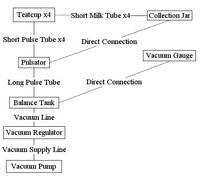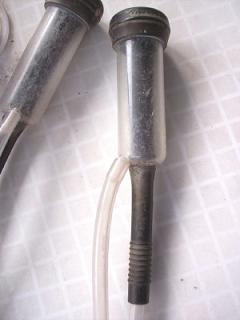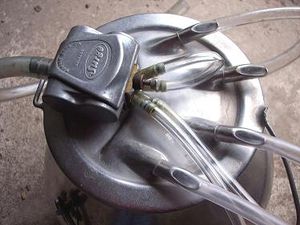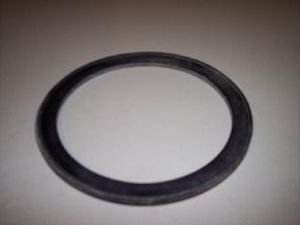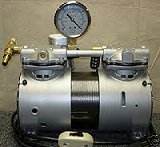Dairy Milker/Research Development: Difference between revisions
Jump to navigation
Jump to search
| Line 36: | Line 36: | ||
[[File:teatcup.jpg|thumb|300px|Teatcup Liner and Shell Example]] | [[File:teatcup.jpg|thumb|300px|Teatcup Liner and Shell Example]] | ||
*'''Teatcup Shell''' - is the component that contains the teatcup liner. The teatcup shell is a hollow cylinder with an opening at the top for the mouthpiece of the teatcup liner, an opening at the bottom for | *'''Teatcup Shell''' - is the component that contains the teatcup liner. The teatcup shell is a hollow cylinder with an opening at the top for the mouthpiece of the teatcup liner, an opening at the bottom for the barrel of the teatcup liner, and an opening at the side for connection to the short pulse tube. For durability, the teatcup shell should be made of stainless steel. | ||
*'''Short Milk Tube''' - is the component that connects the bottom of the teatcup | *'''Short Milk Tube''' - is the component that connects the bottom of the teatcup liner barrel to the top of the collection bucket. Milk flows from the teatcup liner through the short milk tube to the collection bucket. | ||
*'''Short Pulse Tube''' - is the component that connects the side of the teatcup shell to the pulsator. | *'''Short Pulse Tube''' - is the component that connects the side of the teatcup shell to the pulsator. | ||
Revision as of 22:15, 12 September 2011
| Dairy Milker | ||
|---|---|---|
| Home | Research & Development | Bill of Materials | Manufacturing Instructions | User's Manual | User Reviews | 
| |
Research
- Dairy Milker Function is to yield milk from dairy cows.
Theory
Relevant Links
Building Your Own Dairy Milking Unit
Conceptual Notes
Development
Overview
- Milking Unit are the components that attach to the dairy cow and produce pulses for alternating vacuum/atmospheric air entry cycles
- Vacuum System is the components that produce and regulate the vacuum level
Milking Unit
- Teatcup Liner - is the component that attaches onto the teats of the dairy cow. The teatcup liner can be made of rubber or silicone, and has two segments, a mouthpiece and a barrel. The mouthpiece makes contact with the teats while the barrel fits inside the teatcup shell.
- Teatcup Shell - is the component that contains the teatcup liner. The teatcup shell is a hollow cylinder with an opening at the top for the mouthpiece of the teatcup liner, an opening at the bottom for the barrel of the teatcup liner, and an opening at the side for connection to the short pulse tube. For durability, the teatcup shell should be made of stainless steel.
- Short Milk Tube - is the component that connects the bottom of the teatcup liner barrel to the top of the collection bucket. Milk flows from the teatcup liner through the short milk tube to the collection bucket.
- Short Pulse Tube - is the component that connects the side of the teatcup shell to the pulsator.
- Collection Bucket - is the component that accumulates the milk yielded from the dairy cow.
- Collection Lid - is a round narrow metal disk that covers the top of the collection bucket, mounts the pulsator, and connects to the short milk tubes.
- Collection Gasket - is a round rubber component that seals between the collection bucket and collection lid.
- Pulsator - is the machine that alternates between applying vacuum at the teatcups and admitting air at atmospheric pressure to the teatcups
- Normal pulsator rate (rate of opening and closing) is 60 per minute. Pulsation ratio (vacuum time to air entry time) can be 50:50.
- 1 port to pulse line to vacuum reservoir
- 1 port to long pulse tube to claw
- 1 port to atmosphere
- Runs on DC current, usually 12V or 24V
- Long Pulse Tube - is the component that connects the vacuum reservoir to the pulsator.
Vacuum System
- Vacuum Gauge - measures the vacuum level in the vacuum system and outputs an analog reading.
- Vacuum Reserve Tank - can be a series of pipes that distribute vacuum to the pulsator and buffer the vacuum level when air enters the vacuum system.
- Vacuum Pump Filter - is the component connected to the intake of the vacuum pump that prevents particulates from entering and damaging the vacuum pump.
- Vacuum Pump - is the component that produces a vacuum in the vacuum system.
- Vacuum Regulator - prevents vacuum level from increasing excessively by allowing air into the vacuum system when the vacuum level reaches a preset value
- Vacuum Relief Valve - prevents vacuum level from increasing excessively by allowing air into the vacuum system when the vacuum level reaches a preset value in case the vacuum regulator fails
- Sanitary Trap - prevents liquid and particulates from the milking unit entering the vacuum system
Design
- Requirements
- Speed
- Throughput
- Weight
- Size Constraints
- Feed stock
- Design Description
- Calculations
- Drawings and Diagrams
- Concept and Alternatives
- Full Design Views
- Cut-away Views
- Exploded Parts View
- 3D Renders
- Decisions
- Project Team
Industry Standards
| Industry Standard | GVCSTool |
|---|
Funding
Wanted: List of expenses for prototyping and documenting GVCSTool
Peer Reviews
Wanted: Peer reviews from the scientific community regarding the R&D of GVCSTool
Experiments and Prototypes
Wanted: Empirical data on performance
